Kuwait is hot and arid. Most people complain that the sun prevents any kind of outdoor or pedestrian activity during most of the year. How can we manipulate the weather in such a way as to create microclimates that can produce tolerable and even pleasant local weather?
The weather in the winter is very pleasant, and can be controlled through appropriate clothing. The challenge is how to design for the summer. The three major obstacles are:
- Intense summer heat
- Dust
- Lack of precipitation

In a way, we can count ourselves lucky that we are not in a hot/humid region. As you can see in the above graphs, the humidity levels drop sharply during the summer months. This gives us an incredible advantage in that we can use the process of evaporative cooling to cool our buildings and ourselves. Our bodies regulate heat by many processes, one of them being the secretion of sweat. The sweat evaporates from skin and cools down the body. One of the properties of water is that when it evaporates, it requires a lot of heat energy, and it absorbs this heat from the area that surrounds it. The problem in hot/humid regions is that the air is usually saturated with water molecules. You still sweat, but it never evaporates. This means that you can’t regulate the heat generated by your body and you feel hotter still.
We can use this process to cool down our buildings and outdoor spaces. One of the easiest ways to do this is through water misting. These are simple water sprays that shower an outdoor space with small water droplets. The droplets begin to evaporate into the air and will slowly cool down the space. This can also be used to cool down roofs and walls by adding sprinkler systems, but the water waste becomes a problem as well.
Plants and trees can be used to control both heat gain and dust. They act as a natural air filter, trapping dust particles and filtering the air while adding oxygen too. They shade the ground underneath it and cool the air that passes through it. Trees absorb water from the soil which passes through it and eventually evaporates from stomata in its leaves. This process is called evapotranspiration and it cools down the air around the leaves in the same way as sweat.
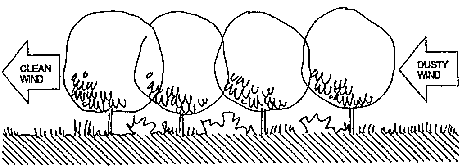
Different materials absorb and reflect heat radiation at vastly different rates. Aluminum would heat up so much faster than concrete, which heats up faster than grass. The air that passes through these materials will heat up accordingly. The space around a building has to take all these factors into account. Hot air passing through trees will cool down considerably.
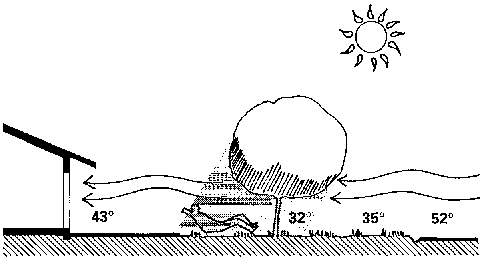
Hot air is lighter than cold air. This means that hot air rises and cool air drops low. A courtyard home therefore has an incredible advantage in that it creates pockets of space where cool air will collect. This property along with a well shaded space means that you can naturally and passively cool down a courtyard to a tolerable level even in the most intensely hot summer days.
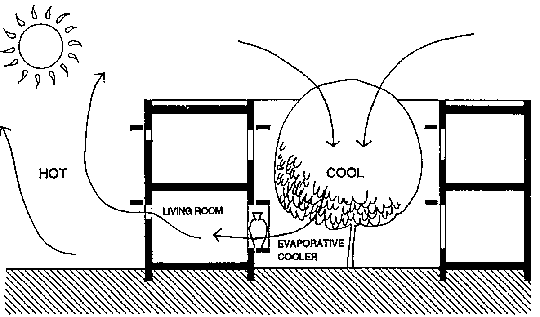
There are many drought tolerant species of plants and trees that are able to survive and thrive in Kuwait. The example below is Bougainvillea, locally known as al-Majnuna. It is a flowering vine that is able to be trained to grow on trellises and along pergolas and arbors. It is fairly disease and pest free and requires little maintenance and watering. A courtyard entirely shaded with this vine would create a wonderfully pleasant microclimate where families can enjoy a private outdoor gathering in the hottest summer day while the sunlight filters through the beautiful colors of the flowers.
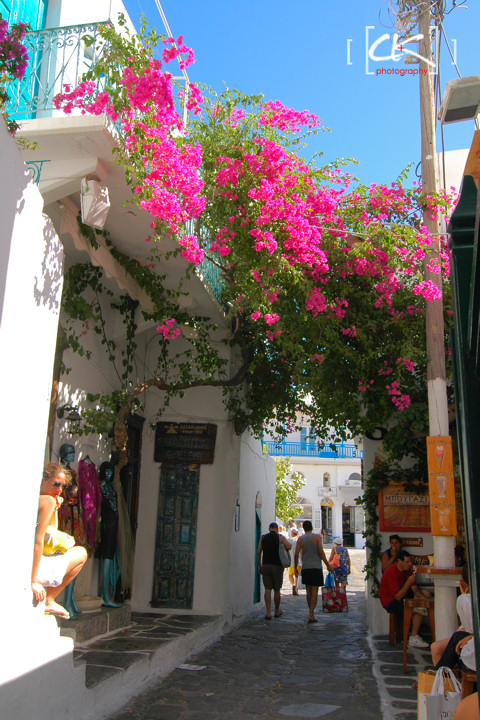
The cooler air dropping from above will be cooled further by the vines, which would trap all the dust that is in the air. The filtered cool air would collect in the courtyard and any air that heats up will rise and escape. I would suggest a large fountain, or a pool with a waterfall be added to the landscape of the courtyard so that a water misting effect is created to cool the space even further.
A courtyard home is not a luxury. It should become the template in which all homes in Kuwait are based on. We must remember how our ancestors used to live and adapt those methods to our contemporary, modern lifestyles. We cannot hide from these challenges in our sealed refrigerators. We have to take control.
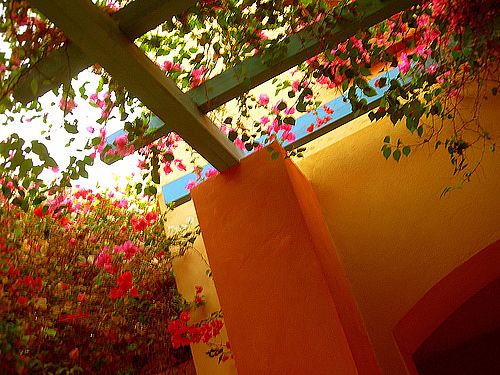
The data used in this post was taken from this meteorological study: http://apps1.eere.energy.gov/buildings/energyplus/weatherdata/2_asia_wmo_region_2/KWT_Kuwait.Intl.AP_KISR.stat

I have this suspicion that a good percentage of the heat in Kuwait is generated up from the asphalt roads. Try going out right after sunset and you can feel it emanating from the ground after hours of direct sunlight beating down on it. It’s even more unpleasant than the heat in broad daylight!
PS: Cool pic of Mykonos bougainvillea 😉
Yes, you’re right. It happens in most major cities. It’s called the Urban Heat Island effect (UHI). http://en.wikipedia.org/wiki/Urban_heat_island
More than asphalt roads (which are black and absorb most of the heat that hits it) you have glass skyscrapers that bounce radiated heat, and concrete that stores it for ages and emits it back when the air is cooler.
They’re trying to find ways to reduce the UHI in cities, with Chicago, Japan and Germany far out ahead of everyone right now. Green roofs, green facades, shaded roads, storm/rain water retention and lots of other neat stuff.
If all the homes in Kuwait had a garden on their roofs, we would reduce the overall demand for AC and practically stop dust from ever entering our habitable zone. It would also look awesome.
We can use greywater (http://en.wikipedia.org/wiki/Greywater) to water the plants. Water filtered from sinks, showers, rain collection etc. No need to throw that away, just reuse it to water the plants and they can dispose of it naturally.
I want to plant the whole roof of our house, but I don’t think its something my family would find appealing. I can live with the heat and dryness, what I can’t stand is the damn dust, seriously, it gets every where, and pretty much stops you from doing a majority of your activities and I feel sorry for those who have allergies because those dusty days are nightmares for them.
I agree with zaydoon, its the asphalt storing the heat as you mentioned as well but I think the track Kuwait is taking we are far from any urban solution which might help.
I think court yards and green area are fantastic in houses, but the way people build in Kuwait is ridiculous. They build block fortresses filling up every square meter they can turning them into mini-apartment buildings for themselves and their kids!
Baladeya should rethink the percentages of the buildings. But the Baladeya doing anything right or legitimate is a dream on its own.
Nice blog by the way! 🙂
Thanks. Well, Kuwait is becoming a little greener. If you think back 10 or 15 years, it wasn’t nearly as green, although it’s still not enough.
I wouldn’t want the Baladeya interfering anymore that they already do. People just need to be informed and shown the alternatives. I can understand why some people feel the need to utilize every square centimeter of the house; land value is so expensive that they can’t afford to buy a plot for they kids, so they have to incorporate them. I do believe that they’re doing it in the wrong way, though, and most of those pancake houses are filled with redundant spaces and oversized rooms.
One thing i’d warn you about a roof garden is to make sure that it’s drained properly, both for the plants (most drought tolerant plants hate wet feet) and so you don’t have any pools of water that leak into the house. The roof can’t be flat, it has to slope a couple of degrees. Soil that’s 60 or 70cm high is enough for light trees, but 20cm is enough for shrubbery and grass. The soil would insulate the roof and make the rooms cooler in the summer and warmer in the winter. Win win.
Our roof is slanted, thats the funny part. We used to play football on it when we were kids and so the ball would always go in different directions and we would lose it to the neighbors if we kick hard.
I keep thinking about it but I don’t think my family would be too keen on it. But all I would want is some grass, and some pots. And a very nice seating area.
what really surprised me about Bahrain the first time I went was how green it was on an individual scale. All the houses had flowers and vines growing on the outer walls. You do not see the same thing in Kuwait on houses, at least outdoors.
lovely architecturaly architected thoughts in this archi-log.. keep it up..
People always need peer validation. As nobody is planting vines in Kuwait people think that there must be something wrong with them, right? In Bahrain, everyone plants vines, so there must be something beneficial. It’s purely a psychological block, as the climatic conditions of Kuwait are better suited to this sort of stuff than the more humid Bahrain.
Great, informative article – I really love this blog and hope you keep up the good work.
I love the idea of doing a roof garden, but are there any companies/gardeners you would recommend for such an endevour – I love gardens and would love to ‘green’ my surroundings even more.
Thanks for the kind words.
You’re looking for a landscape architect. I’m not sure if there are any good dedicated local landscape architects, to be honest. I tend to do all that work in house, myself. I’m sure Jasem would know of some and he might be able to help you out.
You might need a gardener (look in the Mashatil area in al Rai) to maintain the garden itself, but don’t bother asking them to design the space for you. Their experience is really limited to maintenance of the plant and soil, and I would suggest you design the space yourself, or look for a landscape architect to help you out.
Here’s an example of a roof garden in NY:
http://rekuwait.wordpress.com/files/2009/07/picture-11.png
http://rekuwait.wordpress.com/files/2009/07/picture-2.png
http://rekuwait.wordpress.com/files/2009/07/picture-3.png
The wooden frame creates a private space that blocks the view of the neighbors and shades from the sun. There’s not much greenery, but its an example of how to create a habitable outdoor space in a small utilitarian roof.
As you can see, it’s pretty small. Sometimes a cozy space is far more appealing than a bigger one. Doing that on a Kuwaiti roof is fairly simple, but you might need to add an evaporative cooler in there somewhere; an airconditioner than blows cold water through the space or just a simple air misting spray. Other than that, I don’t see why you can’t do something like that for less than a thousand KD.
Nice blog as I was looking towards the information for kuwait. I am visiting the place very soon. Your blog is very very helpful
Not many built homes have adopted the coutyard typology, but there was for the last 10 years a trend of building basement lightwells or 7osh saqit as we call it here. In most cases It does serve its purpose well for delivering light to basements, but it is never utilized well as an outdoor space. I can see potential for many wells to become a lush shaded oasis that would be a great private outdoor area. This maybe an idea for a followup post to this one!
what a really nice short post :p
Hi im trying to find some flowers that can stand the heat in Kuwait. Any where I can go to and by them for my garden.
Try the Mashatel area in al-Rai. It’s a long line of nurseries, i’m sure you’ll find whatever you want there. They’re on the 4th ring road, you can’t miss them.
[…] Trees, trees, trees. Shade and fresh air. […]
Hi,
This is the first time i am reading this blog. And I got addicted to it. Fantastic information. I must commend you on this one , especially since very little information is available on Kuwait. As an Architect & Environmental Architect, I think you are doing a great job of highlighthing the issues and possible solutions as well as the cultural hiccups. I have been trying to promote the green roof myself, with not much luck. Inshallah, one day we will see a very very green Kuwait. A sketch of the same marketed would help dramatically.
Keep up the great work. I will be reading your blog regularly :).
[…] to make by way of an individual contribution or pledge. Do read this to clear some misconceptions: Climate in Kuwait re:kuwait and this: Climate in Kuwait […]